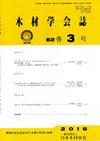Identification and Colors of Wood Buried by a Sector Collapse at Mt. Chokai
IF 0.1
4区 农林科学
Q4 MATERIALS SCIENCE, PAPER & WOOD
引用次数: 1
Abstract
In 2014, large numbers of specimens of buried wood were excavated at the construction site for Nihonkai-tohoku expressway in Nikaho, Akita prefecture, Japan. They had been buried by the Kisakata debris avalanche following a sector collapse at Mt. Chokai in 466 B.C. The aim of this study is to identify the species of the buried wood and to record its characteristics, including colors. Sections made by sliding microtome were observed under a light microscope and samples were identified on the basis of anatomical features. As a result, wood identification of 39 buried specimens, included : Castanea crenata, Quercus section Quercus, Zelkova serrata, Aesculus turbinate, Fagus, Ostrya japonica, and Cryptomeria japonica. The color of buried wood was different from that of wood from living specimens of the same species. Buried wood of C. crenata and Quercus species was black in color, of Z. serrata was dark green, of A. turbinate, Fagus, and O. japonica was brown, and of C. japonica ranged from green-gray to brown. These buried wood specimens are valuable, not only as a model sample to analyze the mechanism by which color and strength of wood change during prolonged burial, but also as a part of the cultural heritage of the area. Therefore, it is significant to know the characteristic properties and chemical composition of buried wood specimens. Our results should provide fundamental and practical information for future investigation.朝开山扇形崩塌掩埋木材的鉴定与颜色
2014年,在日本秋田县二甲町的日本东急高速公路施工现场,挖掘出了大量的埋藏木材标本。它们是在公元前466年Chokai山发生扇形坍塌后被Kisakata碎片雪崩掩埋的。本研究的目的是确定被掩埋木材的种类,并记录其特征,包括颜色。在光学显微镜下观察滑动切片机制作的切片,并根据解剖特征鉴定样品。结果,对39个埋藏标本进行了木材鉴定,包括:栗、栎科栎、泽尔科娃、七叶树、法格斯、鸵鸟和柳杉。埋葬的木材的颜色与同一物种的活标本中的木材不同。C.crenata和Quercus物种的埋木颜色为黑色,Z.serrata为深绿色,A.turbinate、Fagus和O.japonica为棕色,C.japonica的埋木从绿灰色到棕色不等。这些被埋葬的木材标本很有价值,不仅是分析长期埋葬过程中木材颜色和强度变化机制的模型样本,也是该地区文化遗产的一部分。因此,了解埋藏木材标本的特征性质和化学成分具有重要意义。我们的研究结果应该为未来的调查提供基础和实用的信息。
本文章由计算机程序翻译,如有差异,请以英文原文为准。
求助全文
约1分钟内获得全文
求助全文

 求助内容:
求助内容: 应助结果提醒方式:
应助结果提醒方式:


